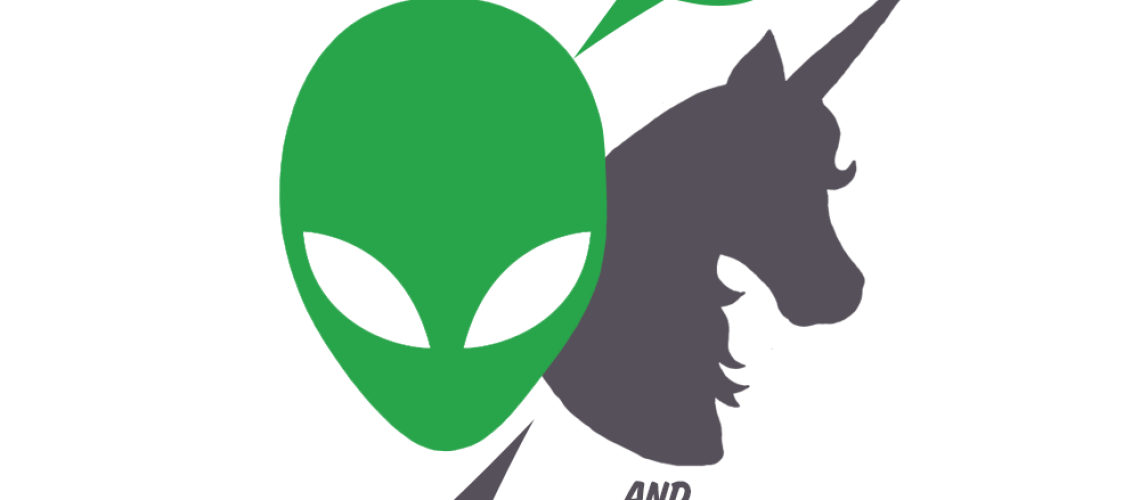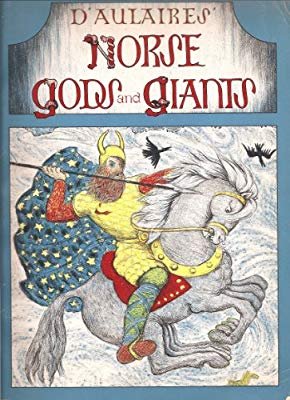It’s hard to pinpoint when my love affair with the prose and poetry of that chilly little speck of a country, who only last year managed to send a squad to compete in the Men’s World Cup, that was founded by a legendarily unruly band of malcontents who didn’t want to bend the knee to Harold Fairhair, that famously still has a population so small and inbred that there’s a dating app to evaluate if you’re too closely related to that hottie to have the warm drawers you do: Iceland. But my infatuation with that volcanic island very possibly started in elementary school, when I came across a copy of Inri and Edgar D’aulaire’s Norse Gods and Giants in my school library.
Raised by a mother who loved Greek and Roman mythology and had a near-complete collection of Horizon magazines (which I have since completed)*, I knew that canon pretty well for a seven year old, but this was all very new to me. At first I insisted on drawing parallels. Odin is Zeus. Freya is Aphrodite. Baldur is Adonis. Loki is Dionysos. Or is he Proteus? A male version of Eris? And what about Thor? There’s nobody quite like Thor. Thor needed considering in his own right.
And then, because it was the 70s, a lot of time passed before I got to take it all beyond a kid’s book and have a look at the Prose Edda, and by that time I’d also become an opera fan (again, thanks to Mom, PBS, and a small band of culture- starved adults who somehow managed on several occasions to get the Texas Opera Company to come perform full scale productions in our town’s acoustic nightmare of a school gymnasiubum) and not just because it was fun to say Gotterdammerung, and I’d realized that the fun stories in the D’aulaire book were just the beginning.
So of course I became a fan of (the infamous) Snorri Sturluson, and when you start checking out his life story a bit, well, that’s just a gateway drug to the Sagas of the Icelanders, which no J.R.R. Tolkien fan with any pretensions to curiosity can not have heard of already…
So there’s that thread, and there is much fun to be had in that amazing body of literature, only a tiny fraction of which has been mined for plots and characters for the TV show Vikings. Though for my money, there are many characters more interesting than Ragnar Fuzzybritches to have drawn on. Hallfred the Troublesome Poet, for instance. Or Gunnlaug Serpent Tongue. Or the outlaw, Gisli.
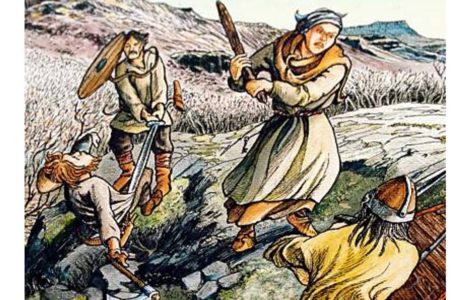
But maybe I’ve just listened to too much of the Saga Thing podcast. If that’s even possible. Really, anyone who’s even a little curious about saga literature should go have a listen to John and Andy, professional and credentialed literature wonks, who celebrate and critique the sagas Rex Factor/X-factor style. Tell them Kate sent you. They know me. I’m the one who started the Saga Thing drinking game.
Meanwhile, I grew up, got a degree in languages and literature I’ve done little with unless you count my two extremely weird connections of extremely weird sonnets, and realized that despite that degree there was still a lot of important literature I hadn’t read. I could and would talk your ear off for hours about Joseph Conrad or Henry Adams or Hart Crane or Jorge Luis Borges, but… even Borges never won the Nobel prize, I had long known.
But so, who did?
A whole lot of people I hadn’t read yet. And some, yes, that I had that I didn’t especially like, but lots that were new to me. And so I challenged myself to read as many of the Nobel laureates as I could. **
Which brought me to Halldor Laxness.
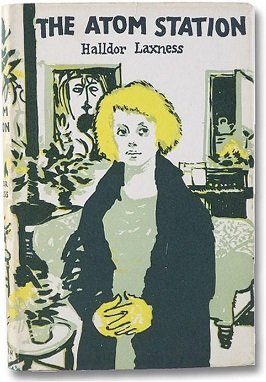
Allow me to swoon for a moment.
Laxness is hard to describe, and I’m no expert on his work; indeed, I still haven’t read several of his Important Books. But The Atom Station made me realize that colonialism hasn’t died, witness any bit of Europe during the Cold War that played host to a NATO military outpost; Independent People made epic heroes of ordinary poor folk scratching out a living in the toughest country; The Fish Can Sing explored Iceland’s relationships to the rest of Europe through the story of a fisherman’s son who dreams of becoming a “world singer”, and speaking of the world, World Light, which I just spent most of the autumn of 2018 slowly savoring, just astonished me in every way. It’s not everybody who can make me laugh even as I encounter characters who say things like “This is heaven; more dead children! More dead children!”
It’s a peculiar, bleak and chilly humor that Laxness has, but it’s funny nonetheless. I think of it as quite Scandinavian, but I know those lands only via books and film and TV, so take that with a grain.
Meanwhile, a Twitter friend from Iceland, after slightly disappointing me with the news that a lot of more modern Icelandic writers do mostly crime fiction, suggested I check out this guy Sjón. AKA Johnny Triumph for you Sugarcubes fans. Oh, he writes novels, too?
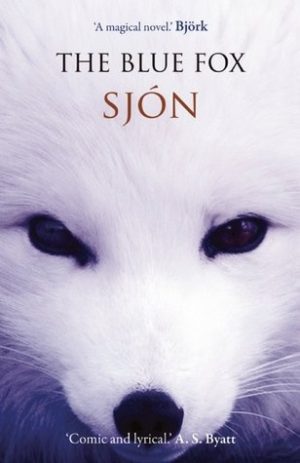
At the time, not a lot of his stuff was available in English, but there was The Blue Fox, and it proved to be a marvelous genre-blend of historical and crime fiction with magical realism and I was well pleased.
Then just last year, his jaw-dropping trilogy known now as CoDex 1962 came out in English. I devoured it in a matter of days, then turned around and read it all again from the beginning because it has one of *those* endings that begs a complete re-interpretation of the stories you’ve just read, even though this refrain imagining the souls of the entire cohort of children born in Iceland joining a slowly growing gathering as they die off, waiting to be joined by their fellows, that runs trough the third book kept breaking my heart.
A recent glance at Amazon revealed that lots more of Sjón’s books are now available, translated into English by Victoria Crib and I got a whole bunch of them for myself for Christmas, along with some more Laxness, and my cup runneth over. Yours can, too. There’s still lots to explore!
Oh, and while I gushed on Twitter over CoDex 1962 with fellow Skiffon and Fantite Rachel Cordasco, Sjón himself decided to follow me there! So he might even read this. So, hi Sjón, hi!!! I’m about to start on From the Mouth of the Whale.
Truly, it’s a mánuður af gleði.
*I still maintain that a thoughtful perusal of these nifty and beautiful hardcover periodicals constitutes a liberal arts education in itself, and none of my professors at Bodacious Bard College, who were often surprised that the Wyoming girl knew stuff until they learned what I’d spent my childhood playing with, ever disagreed with me on this.
**As of this writing, I’ve read at least one work by 42 of the 114 laureates. I’m about to make it 43, as I just plundered the Open Library for a survey of Serbian laureate Ivo Andric’s best.

